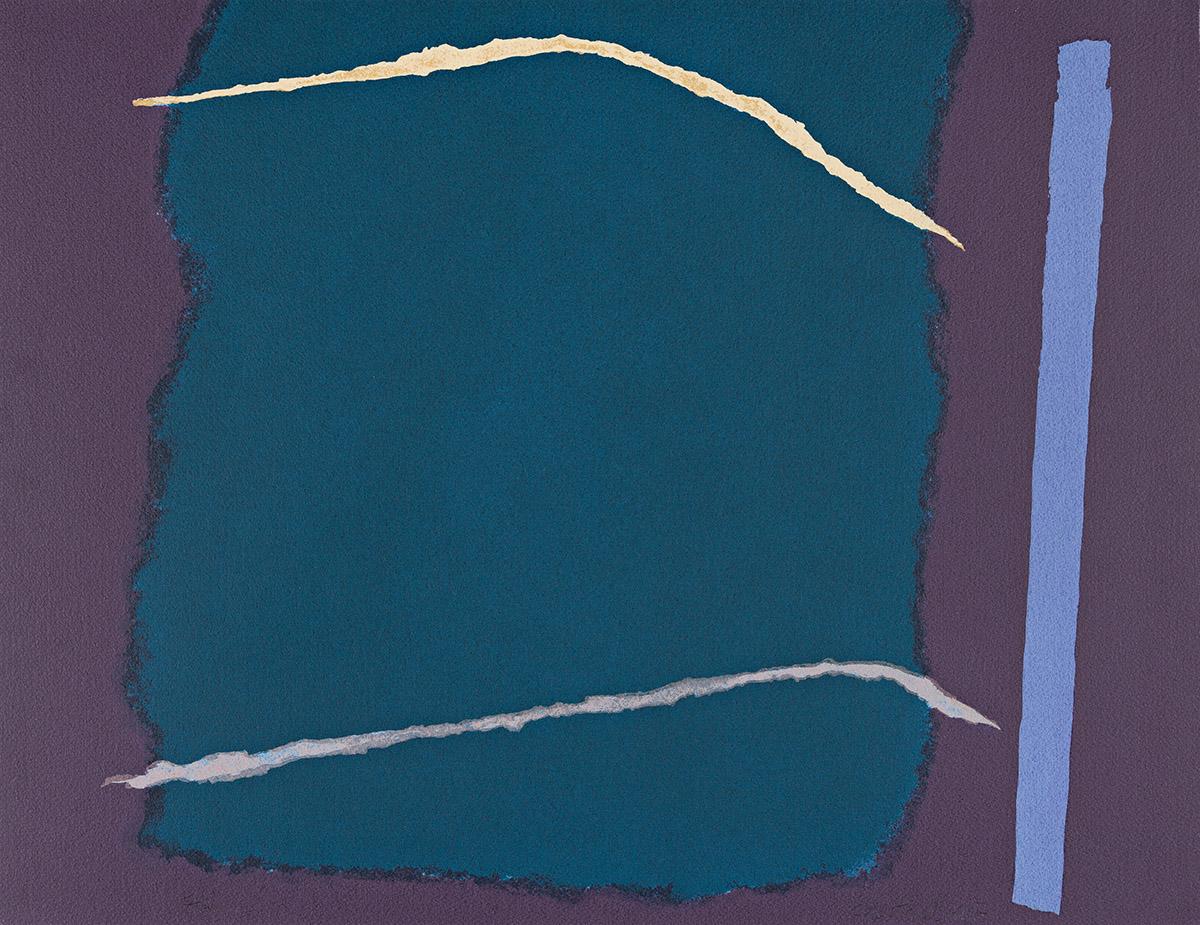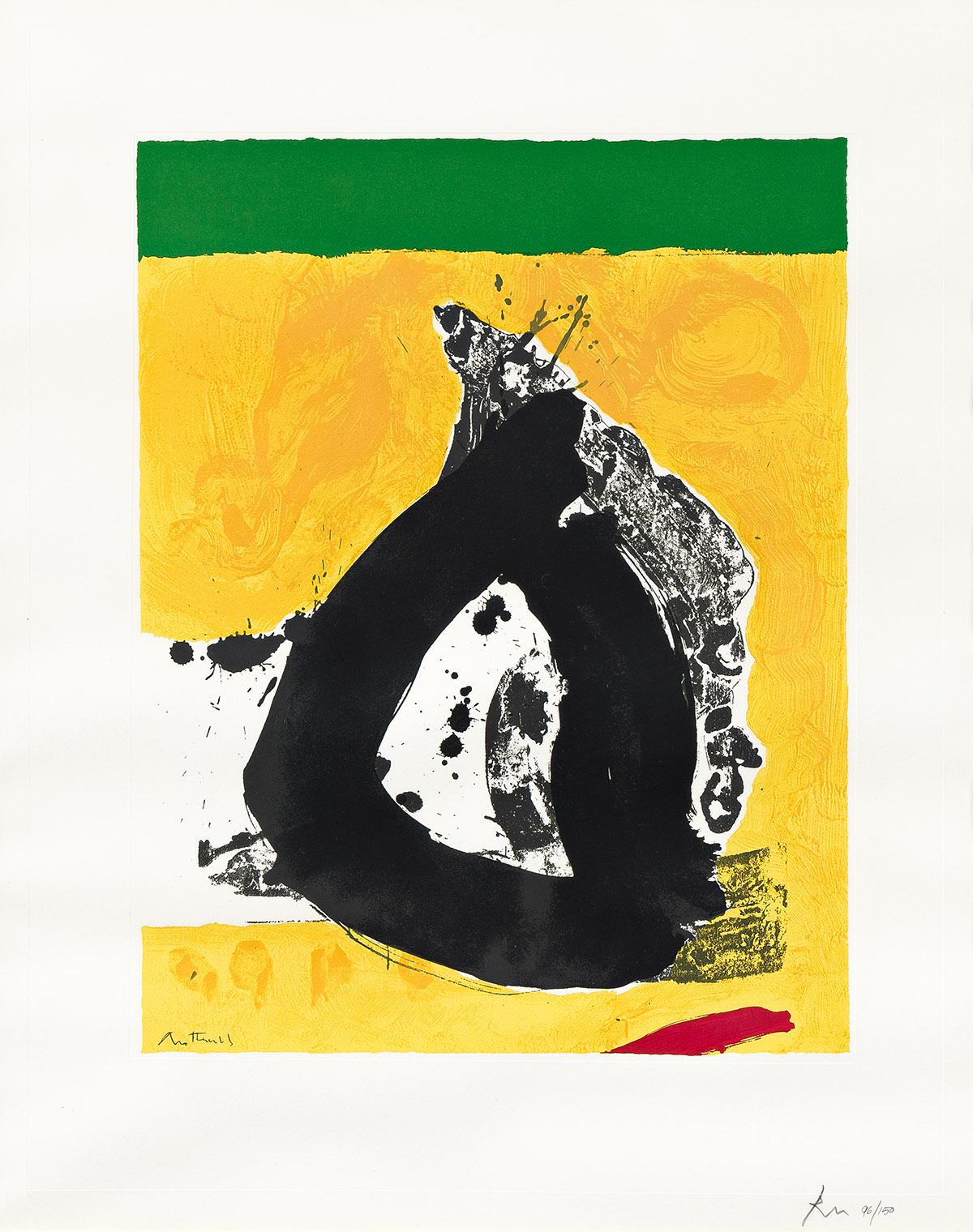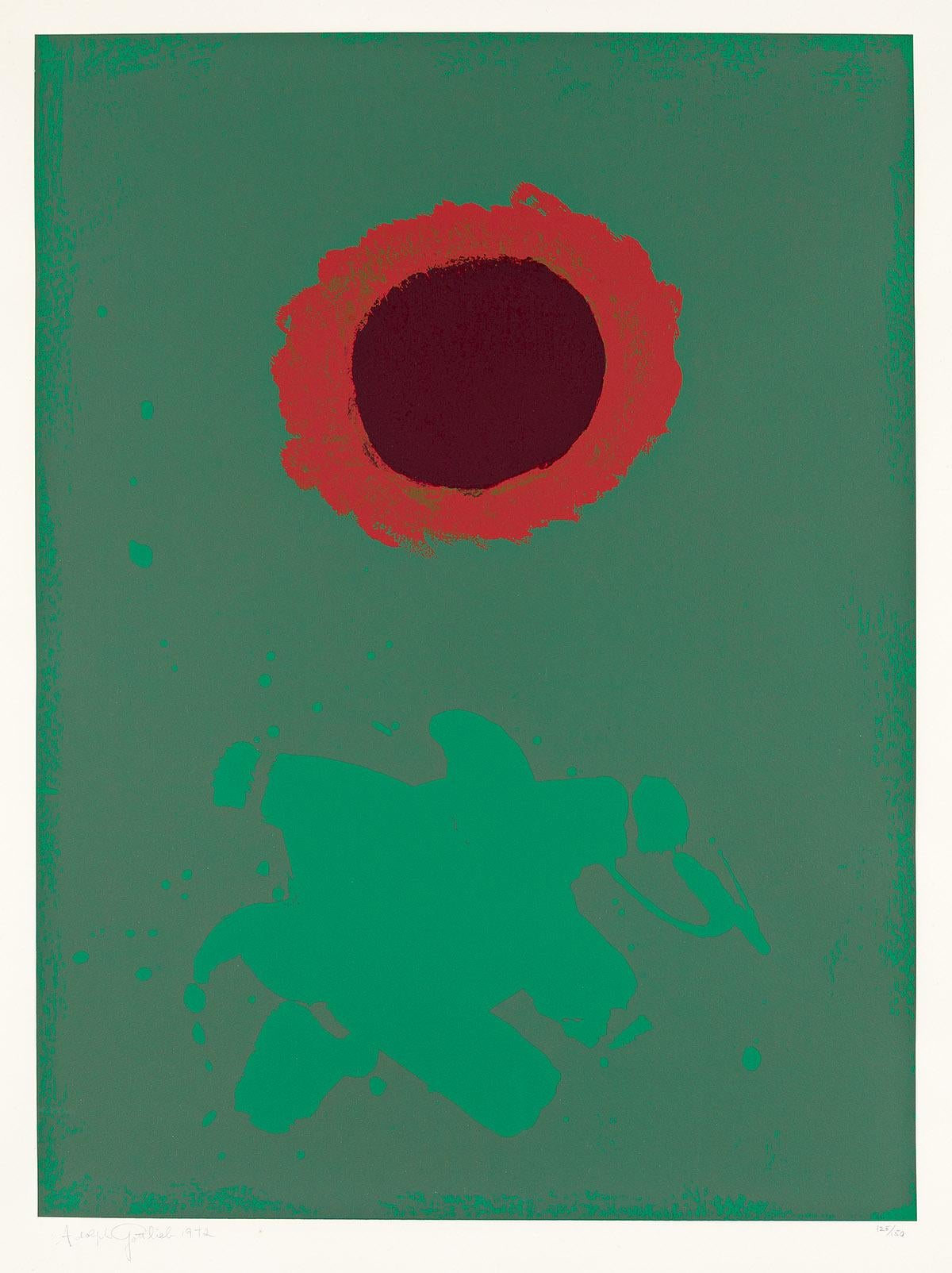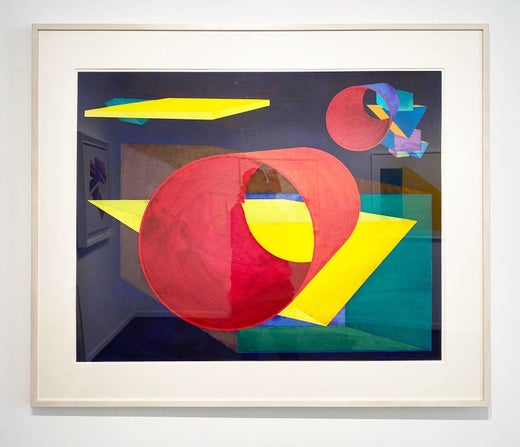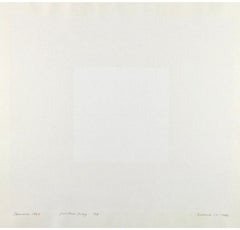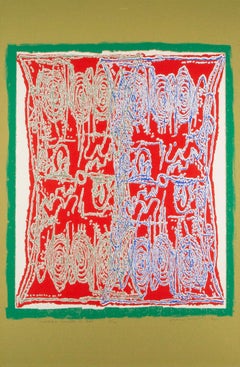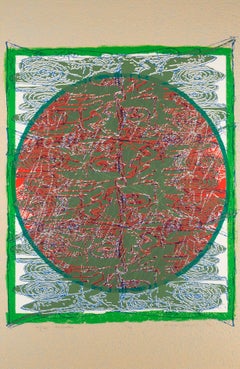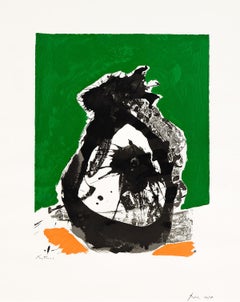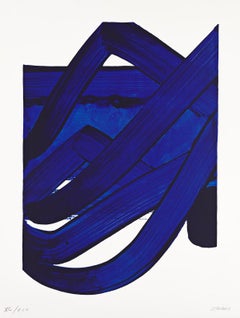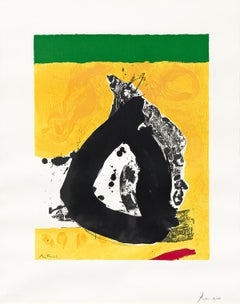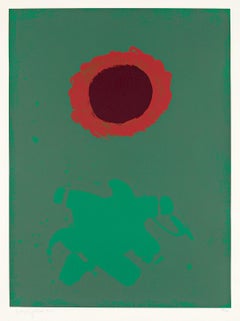Articles similaires à Untitled - 20th Century Brightly Colored Print, Yellow, Red, Green + Grey Circle
Vous voulez plus d'images ou de vidéos ?
Demander au vendeur plus d'images ou de vidéos
1 sur 10
Al HeldUntitled - 20th Century Brightly Colored Print, Yellow, Red, Green + Grey Circle1968
1968
À propos de cet article
Born in Brooklyn in 1928 to Polish immigrants, Al Held claims to have been expelled from high school in the Bronx in 1944. After serving in the U.S. Navy from 1945 to 1947, Held associated with members of the activist group Folksay who viewed art as a forceful medium for political and social protest. Held had also cultivated an interest in visual art, primarily through film, and enrolled in classes at the Arts Students League in 1948 on a stipend from the G.I. Bill.
Held’s radical convictions were nurtured by his father’s Marxist beliefs and regular household political discussions. His earliest work was entirely figurative and shows the influence of Social Realism. Held had planned to study in Mexico with the renowned muralist David Alfaro Siqueiros, whose works’ monumental scale and expressive political content inspired him, but was unable to attend after the school lost its G.I. accreditation. Held opted to study instead at the Académie de la grande chaumière in Paris. Before leaving for France, Held was impressed by Jackson Pollock’s paintings in New York, but it was not until he arrived in Paris that he completely abandoned figuration.
In Paris Held took classes with the sculptor Ossip Zadkine at the academy and became part of the American expatriate circle that included artists Sam Francis, Ellsworth Kelly, Joan Mitchell, Haywood “Bill” Rivers, and George Sugarman, among others. Held received his first solo exhibition of small abstract works in Paris at the artist-run Galerie Huit in 1952. On his return to New York, Held quickly entered the orbit of Abstract Expressionist painters, particularly Franz Kline and Mark Rothko who mentored the younger Held. His post-Paris paintings of the 1950s were heavily impastoed, tactile canvases that retain the expressive gesture of Abstract Expressionism. He received his first New York solo exhibition at the Poindexter Gallery in 1959.
Held is considered a prominent figure among second-generation Abstract Expressionists, but his persistent exploration of illusionistic potential within abstraction and theoretical attitudes consistently defied many of the labels of post–Abstract Expressionist movements. In the early 1960s, Held’s paintings moved toward a growing sense of overall clarity and concreteness. Because of their sharpened contours, increasingly geometric forms, and gradually enlarged scale, he was associated with practitioners of Hard-edge painting such as Kelly and Frank Stella. However, Held remained distinct for his bold rejection of critic Clement Greenberg’s modernist doctrine, particularly its insistence on flatness. In 1967, Held became tired of the reductive geometric quality and flatness of his work and strove to incorporate space and volume into his canvases. His paintings of 1967–68 were exclusively black and white; after this point he began to explore the three dimensionality of the canvas by punching holes in it and structuring his compositions using vanishing points. After 1978, he began to experiment with vibrant colors in his illusionistic geometric compositions. Despite the shifts in Held’s evolving logic to reconcile ordered abstraction and illusionism, the dimensions of his canvases remained a constant throughout his career. Held’s persistent drive for architectural scale also found expression in several noteworthy murals, the first of which, I and We (1967), was commissioned for Walter Gropius’s Tower East in Cleveland. In 2005 Held completed a mural for the New York City Subway system; he died later that year at his home in Todi, Italy.
Held was an associate professor of art, Yale University, New Haven, from 1962 to 1980. He received numerous awards and grants, including the Frank G. Logan Medal from the Art Institute of Chicago (1964), John Simon Guggenheim Memorial Foundation Fellowship in painting (1966), and a six-month residency at the American Academy in Rome (1981). In 1984 Held was elected to the American Academy of Arts and Letters.
Although Held’s committed search for an alternative to the reductivist logic that evolved out of Abstract Expressionism did not gain him immediate acceptance in the 1950s art world, his work was presented in many significant group exhibitions in the 1960s at the Guggenheim Museum (1961, 1966); Jewish Museum, New York (1963); Los Angeles County Museum of Art (1964); Museum of Modern Art, New York (1964); and Documenta, Kassel, West Germany (1968), among other venues. Notable solo exhibitions include those at the Stedelijk Museum, Amsterdam (1966); traveling exhibitions at the San Francisco Museum of Art (now San Francisco Museum of Modern Art) and the Corcoran Gallery of Art, Washington, D.C. (1968) as well as at the Institute of Contemporary Art, Philadelphia, and Contemporary Arts Museum, Houston (1968); Whitney Museum of American Art, New York (1974); Institute of Contemporary Art, Boston (1978); FIAC Foire internationale d’art contemporain, Grand Palais, Paris, with André Emmerich Gallery (1981); and P.S. 1 Contemporary Art Center (now MoMA PS1), New York (2002).
- Créateur:Al Held (1928 - 2005, Américain)
- Année de création:1968
- Dimensions:Hauteur : 98 cm (38,59 po)Largeur : 67 cm (26,38 po)
- Support:
- Mouvement et style:
- Période:
- État:
- Adresse de la galerie:Kingsclere, GB
- Numéro de référence:1stDibs : LU2718216449622
Al Held
Alvin Jacob Held, (1928-2005) Al Held a gagné sa place dans les annales de l'art contemporain américain avec ses toiles géométriques audacieuses qui ont porté l'abstraction à un autre niveau. Ses cubes et ses plans imbriqués flottant librement invitent le spectateur à entrer dans un paysage vertigineux qui semble s'étendre à l'infini. "D'immenses structures architecturales courbent et tranchent ces peintures complexes, s'enchevêtrant souvent dans des structures cellulaires", note le Times of London. "Les spectateurs avaient l'impression d'explorer un univers mystérieux, et Heldly n'a jamais perdu sa croyance passionnée dans la capacité de la peinture abstraite à créer un nouveau monde sublime."
Heldly a grandi à Brooklyn, dans l'État de New York. Adolescent, il a manqué tellement de jours de cours au lycée qu'on lui a suggéré d'envisager de le quitter complètement. Il a fini par obtenir un diplôme de cours du soir et a passé deux ans dans la marine américaine. De retour à New York, il suit les cours de l'Art Students League, puis étudie à l'Académie de la Grande Chaumière à Paris au début des années 1950. La première exposition personnelle de son œuvre y a été organisée en 1952 à la Galerie Huit. Le travail abstrait de Held a pris un ton plus ordonné et formel, aidé par le passage de la peinture à l'huile à la peinture acrylique en 1959, et il a eu sa première exposition personnelle à New York la même année à la Poindexter Gallery. Se situant entre le minimalisme et la peinture Color Field", écrit Ken Johnson, journaliste au New York Times, à propos de la décennie suivante de la carrière de Heldly, "il a produit des œuvres lisses et simplifiées, basées sur des lettres agrandies de l'alphabet". Et à la fin des années 60 et dans les années 70, il a réalisé des images complexes en noir et blanc de cubes aux contours nets, de pyramides et d'autres formes géométriques flottant dans des espaces illusoires d'une profondeur indéterminée."
Certaines des œuvres les plus connues de Heldly sont ces cubes flottants en noir et blanc, une série qu'il a commencée en 1967. L'un des plus grands, qui s'étend sur plus de 90 pieds de long, a été installé à l'Empire State Plaza à Albany, dans l'État de New York. À la fin des années 1970, il a brusquement recommencé à utiliser la couleur, et les formes géométriques sont devenues si précises qu'on les a parfois confondues avec de l'art généré par ordinateur. Heldly considérait que ses images n'étaient pas sans rappeler celles de l'art religieux, déclarant un jour à un intervieweur que "historiquement, les prêtres et les sages pensaient que c'était le travail de l'artiste de rendre crédibles les images du paradis et de l'enfer, même si personne n'avait connu ces lieux", a-t-il dit, selon sa notice nécrologique du Chicago Tribune.
Heldly a passé 20 ans à enseigner à l'université de Yale. Représenté par la Robert Miller Gallery à New York, qui a organisé ce qui allait être sa dernière exposition de nouvelles œuvres en 2003, les œuvres de Held ont été avidement recherchées par les amateurs d'art contemporain du monde entier et ont fait partie des collections permanentes de nombreuses institutions, dont le Metropolitan Museum of Art et le Museum of Modern Art. - Carol Brennan
À propos du vendeur
Aucune évaluation pour le moment
Vendeur professionnel agréé
Chaque vendeur répond à des normes strictes en matière d'authenticité et de fiabilité
Vendeur 1stDibs depuis 2024
37 ventes sur 1stDibs
Temps de réponse habituel : 16 heures
- ExpéditionRecherche du devis...Expédition depuis : Kingsclere, Royaume-Uni
- Politique des retours
Certaines parties de cette page ont été traduites automatiquement. 1stDibs ne garantit pas l'exactitude des traductions. L'anglais est la langue par défaut de ce site web.
Garantie d'authenticité
Bien qu'il soit peu probable que la situation se présente, dans le cas où vous rencontreriez un problème d'authenticité d'un article, contactez-nous dans un délai d'un an pour obtenir un remboursement intégral. DétailsGarantie de remboursement
Si votre article n'est pas conforme à la description, est endommagé pendant le transport ou ne vous est pas livré, contactez-nous sous 7 jours pour obtenir un remboursement intégral. DétailsAnnulation sous 24 heures
Vous disposez d'un délai de 24 heures pour annuler votre achat sans motif.Des vendeurs professionnels agréés
Nos vendeurs de renommée mondiale doivent respecter des normes strictes en matière de service et de qualité, afin de préserver l'intégrité de nos fiches produit.Garantie d'alignement des prix
Si vous constatez qu'un autre vendeur a mis en vente le même article à un prix inférieur sur un autre site, nous nous alignerons sur ce prix.Livraison en toute confiance à l'international
Notre réseau de transporteurs de premier ordre propose des options d'expédition spécialisées dans le monde entier, y compris des livraisons personnalisées.Plus d'articles de ce vendeur
Tout afficherSummer, from The Four Seasons, 1966 - Sérigraphie blanche minimaliste
Par Richard Lin
Summer, extrait de The Four Seasons de Richard Lin, 1966
Informations complémentaires :
Support : sérigraphie sur papier TH Saunders
68.5 x 91 cm
27 x 35 7/8 in
signée, datée deux f...
Catégorie
20ième siècle, Estampes - Abstrait
Matériaux
Écran
En janvier 1973 : 19 (DRU Christmas Card), 1976 - Sérigraphie colorée abstraite
Par Patrick Heron
Cette sérigraphie a été commandée par la Design Research Unit comme carte de Noël pour 1976. Il s'agit d'une réinterprétation de la sérigraphie "JANUARY 1973 : 19" de Patrick Heron, ...
Catégorie
Fin du 20e siècle, Estampes - Abstrait
Matériaux
Écran
Manteau multicolore rouge de la suite Powhatan, 1992 - Impression abstraite rouge
Par Gordon House
Gordon House est né en 1932 à Pontardawe, dans le sud du Pays de Galles. Son exposition précoce à l'art lors de visites à la Glynn Vivian Art Gallery, lorsqu'il était jeune, a inspir...
Catégorie
Fin du 20e siècle, Estampes - Abstrait
Matériaux
Écran
Après Powhatan, de la suite After Powhatan, 1992 - Grande impression abstraite verte
Par Gordon House
Gordon House est né en 1932 à Pontardawe, dans le sud du Pays de Galles. Une exposition précoce à l'art lors de visites à la Glynn Vivian Art Gallery a inspiré House dans ses efforts...
Catégorie
années 1990, Estampes - Abstrait
Matériaux
Écran, Papier
Sans titre (Tiles), 2005/2017 - Impression texturée à motifs de Rachel Whiteread
Par Rachel Whiteread
Rachel Whiteread est l'un des principaux sculpteurs britanniques contemporains. Née à Londres en 1963, elle a étudié la peinture à l'école polytechnique de Brighton de 1982 à 1985 et...
Catégorie
XXIe siècle et contemporain, Estampes - Abstrait
Matériaux
Lithographie, Écran
Symo (bleu/vert), 1967, sérigraphie abstraite des lignes géométriques de Richard Allen
Par Richard Allen
Richard Allen est un artiste abstrait du XXe siècle qui a travaillé dans les domaines de la peinture, du graphisme et des technologies.
Allen est né à Worcester en 1933. Influenc...
Catégorie
20ième siècle, Estampes - Abstrait
Matériaux
Écran
Suggestions
Le Basque Suite n°2
Par Robert Motherwell
Très bonne impression de cette sérigraphie en couleur sur papier J. B. Green. Paraphé et numéroté 134/150 au crayon par Motherwell. Imprimé par Kelpra Studio, Londres. Publié par Mar...
Catégorie
années 1970, Expressionnisme abstrait, Estampes - Abstrait
Matériaux
Couleur, Écran
Sérigraphie No. 18
Par Pierre Soulages
Superbe impression de cette sérigraphie en couleur sur papier vélin blanc. Signé et numéroté XC/CCC au crayon par Soulages. Publié par le Comité des Jeux Olympiques, Lausanne. Extrai...
Catégorie
années 1980, Expressionnisme abstrait, Estampes - Abstrait
Matériaux
Couleur, Écran
20 000 $US
Le Basque Suite n°6
Par Robert Motherwell
Très bonne impression de cette sérigraphie en couleur sur papier J. B. Green. Paraphé et numéroté 96/150 au crayon par Motherwell. Imprimé par Kelpra Studio, Londres. Publié par Marl...
Catégorie
années 1970, Expressionnisme abstrait, Estampes - Abstrait
Matériaux
Couleur, Écran
Vert chrome
Par Adolph Gottlieb
Très bonne impression de cette sérigraphie couleur sur Arches. Signé, daté et numéroté 125/150 au crayon par Gottlieb. Imprimé par Kelpra Studio, Londres, avec le cachet au verso. Pu...
Catégorie
années 1970, Expressionnisme abstrait, Estampes - Abstrait
Matériaux
Couleur, Écran
4 500 $US
Sans titre (Champ d'infini - Série Lefkada)
Par Theodoros Stamos
Très bonne impression de cette sérigraphie en couleur sur papier vélin blanc. Épreuve d'artiste, en dehors de l'édition de 75. Signé et portant la mention "épreuve d'essai en couleur...
Catégorie
années 1970, Expressionnisme abstrait, Estampes - Abstrait
Matériaux
Couleur, Écran
Sonate
Par Mark Tobey
Très bonne impression, richement encrée, de cette sérigraphie en couleur sur Japon nacré. L'édition de luxe en chiffres romains de 60 exemplaires sur Japon nacré, à côté de l'édition...
Catégorie
années 1970, Expressionnisme abstrait, Estampes - Abstrait
Matériaux
Couleur, Écran
1 500 $US

